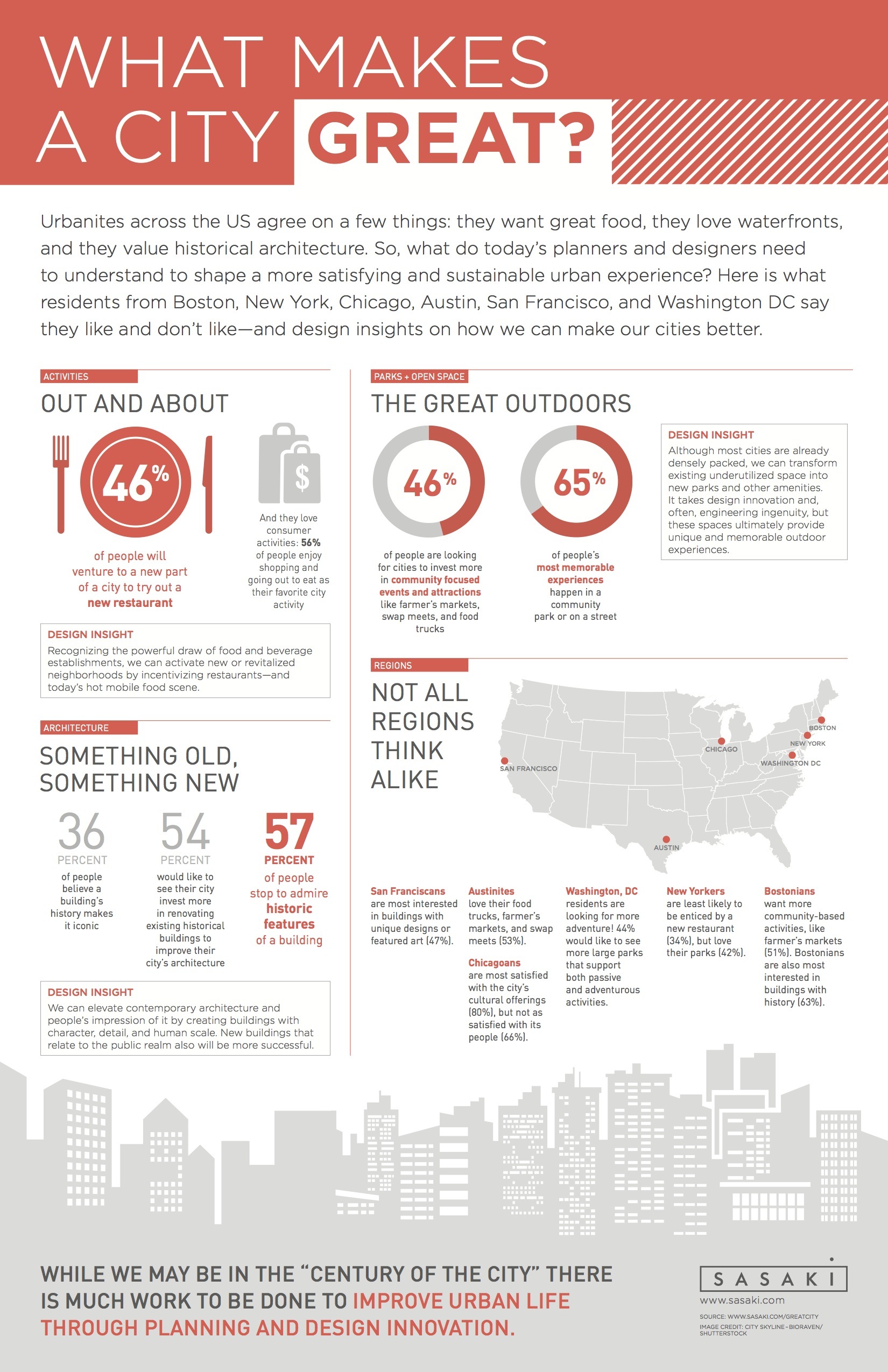A new study released by planning and design firm Sasaki Associates has found that food is a major driver of the American urban experience: 82 percent of urbanites appreciate their city’s culinary offerings, and a new restaurant is the top reason the majority of them (46 percent) would venture to a new part of their city. This is compared to 25 percent of people who are incentivized by a new store and 16 percent by a sporting event.
These preferences vary by region, however, with Bostonians most likely to be enticed by a new restaurant (59 percent) versus New Yorkers (34 percent), whose apparent abundance of choice ranked them lowest on this question. And the majority of people (41 percent) consider food and restaurants to be the most outstanding aspect of cities they love to visit.
Working with an independent research firm, Sasaki developed “The State of the City Experience,” which surveyed 1,000 people living and working in one of six cities: Boston, New York, San Francisco, Chicago, Austin, and Washington DC. The findings—and Sasaki’s insights—related to architecture, activities, parks, and transportation have major implications for cities, planners, and designers.
Beyond food, respondents also enjoy consumer activities such as shopping and going out to eat (56 percent) the most, followed by programmed events such as farmer’s markets, outdoor concerts and food trucks (45 percent). And they want more: 46 percent of respondents said they want their cities to invest in more community-focused events and attractions such as farmer’s markets, swap meets, and food trucks for their open spaces.
As for buildings, people love historic structures. When asked what makes a building iconic, most said it was its history (36 percent). And when walking along a downtown street, most people will stop to admire buildings that are historic (57 percent), versus those featuring public art, modern design, or their city’s tallest buildings.Regionally, Bostonians are the biggest admirers of historic buildings (63 percent), while San Franciscans are more likely to be attracted to buildings that prominently feature public art or very unique design elements (47 percent). Residents of Chicago, which has the nation’s tallest building, are more likely to admire skyscrapers (23 percent).
To improve their city’s architectural character, more than half of respondents (54 percent) would like to see their city renovating historical buildings, compared with22 percent who would like more unusual architecture.
“While those surveyed were unimpressed with modern architecture, we believe it is because today’s contemporary buildings tend to prioritize quantity and speed over quality and mission,” said Sasaki principal Victor Vizgaitis, AIA. “As planners and designers, our job is to understand what people want and balance these desires with the big picture—economic realities, cultural needs, environmental concerns, and design opportunities—ultimately helping to shape a more satisfying and sustainable urban experience.”
When it comes to the built environment, shared public spaces rule the day. Most people remember their favorite city experience taking place in a park or on a street (65 percent) compared to just 22 percent who said that special moment occurred in a private building. This is especially true among New Yorkers.
Reflecting a national trend of cities reclaiming their waterfronts, areas along rivers, lakes, or the ocean are the most popular open spaces across the country (47 percent) compared to 14 percent who prefer small urban parks or 8 percent who like their city’s trail systems.
So, what do Americans hate the most about their cities? Traffic. Overall, 41 percent percent say it’s what frustrates them the most, followed by not enough parking (23 percent) and poor public transportation (14 percent). This provides great opportunity for new technologies to rethink how vehicles can be used more effectively by urbanites, both in terms of commuting and sustainability.
Despite transportation frustrations, 60 percent of city dwellers plan to stay put in the next five years, either living where they do now or in a different part of the city.
The infographic below summarizes key findings. For the full report: www.sasaki.com/greatcity
Methodology
Sasaki commissioned independent research firm Equation Research to survey 1,000 people who live across six cities: Austin, Boston, Chicago, New York, San Francisco, and Washington DC. The study was conducted in May 2014.
About Sasaki
Collaboration is one of today's biggest buzzwords—but at Sasaki, it's at the core of what we do. We see it not just as a working style, but as one of the fundamentals of innovation. Our practice comprises architecture, interior design, planning, urban design, landscape architecture, graphic design, and civil engineering, as well as financial planning and software development. Among these disciplines, we collaborate in equilibrium. From our headquarters in Watertown, Massachusetts, we work locally, nationally, and globally. For more information about Sasaki, please visit: http://www.sasaki.com.
Related Stories
Adaptive Reuse | Sep 12, 2024
White paper on office-to-residential conversions released by IAPMO
IAPMO has published a new white paper titled “Adaptive Reuse: Converting Offices to Multi-Residential Family,” a comprehensive analysis of addressing housing shortages through the conversion of office spaces into residential units.
Mixed-Use | Sep 10, 2024
Centennial Yards, a $5 billion mixed-use development in downtown Atlanta, tops out its first residential tower
Centennial Yards Company has topped out The Mitchell, the first residential tower of Centennial Yards, a $5 billion mixed-use development in downtown Atlanta. Construction of the apartment building is expected to be complete by the middle of next year, with first move-ins slated for summer 2025.
Healthcare Facilities | Sep 9, 2024
Exploring the cutting edge of neuroscience facility design
BWBR Communications Specialist Amanda Fisher shares the unique considerations and challenges of designing neuroscience facilities.
Office Buildings | Sep 6, 2024
Fact sheet outlines benefits, challenges of thermal energy storage for commercial buildings
A U.S. Dept. of Energy document discusses the benefits and challenges of thermal energy storage for commercial buildings. The document explains how the various types of thermal energy storage technologies work, where their installation is most beneficial, and some practical considerations around installations.
Office Buildings | Sep 5, 2024
Office space downsizing trend appears to be past peak
The office downsizing trend may be past its peak, according to a CBRE survey of 225 companies with offices in the U.S., Canada, and Latin America. Just 37% of companies plan to shrink their office space this year compared to 57% last year, the survey found.
University Buildings | Sep 4, 2024
UC San Diego’s new Multidisciplinary Life Sciences Building will support research and teaching in both health and biological sciences
The University of California San Diego has approved plans for a new Multidisciplinary Life Sciences Building, with construction starting this fall. The 200,000-sf, six-level facility will be the first building on the UC San Diego campus to bridge health science research with biological science research and teaching.
Codes and Standards | Sep 3, 2024
Atlanta aims to crack down on blighted properties with new tax
A new Atlanta law is intended to crack down on absentee landlords including commercial property owners and clean up neglected properties. The “Blight Tax” allows city officials to put levies on blighted property owners up to 25 times higher than current millage rates.
Resiliency | Sep 3, 2024
Phius introduces retrofit standard for more resilient buildings
Phius recently released, REVIVE 2024, a retrofit standard for more resilient buildings. The standard focuses on resilience against grid outages by ensuring structures remain habitable for at least a week during extreme weather events.
Construction Costs | Sep 2, 2024
Construction material decreases level out, but some increases are expected to continue for the balance Q3 2024
The Q3 2024 Quarterly Construction Insights Report from Gordian examines the numerous variables that influence material pricing, including geography, global events and commodity volatility. Gordian and subject matter experts examine fluctuations in costs, their likely causes, and offer predictions about where pricing is likely to go from here. Here is a sampling of the report’s contents.
Adaptive Reuse | Aug 29, 2024
More than 1.2 billion sf of office space have strong potential for residential conversion
More than 1.2 billion sf of U.S. office space—14.8% of the nation’s total—have strong potential for conversion to residential use, according to real estate software and services firm Yardi. Yardi’s new Conversion Feasibility Index scores office buildings on their suitability for multifamily conversion.


















